The two VM tall letters, so-called gallows, are the only four letters that do not have a similar shaped letter in other 15th century manuscripts. The EVA-k and -t have been identified as such by other transcription alphabets, and this is also how I read them, since there is no likeness for German K or T. The transformation could be rationalized with the assumption that the VM K and T could be written with one stroke, which was important for the cursive writing.
The other two tall VM glyphs were identified as EVA-p and EVA-f.
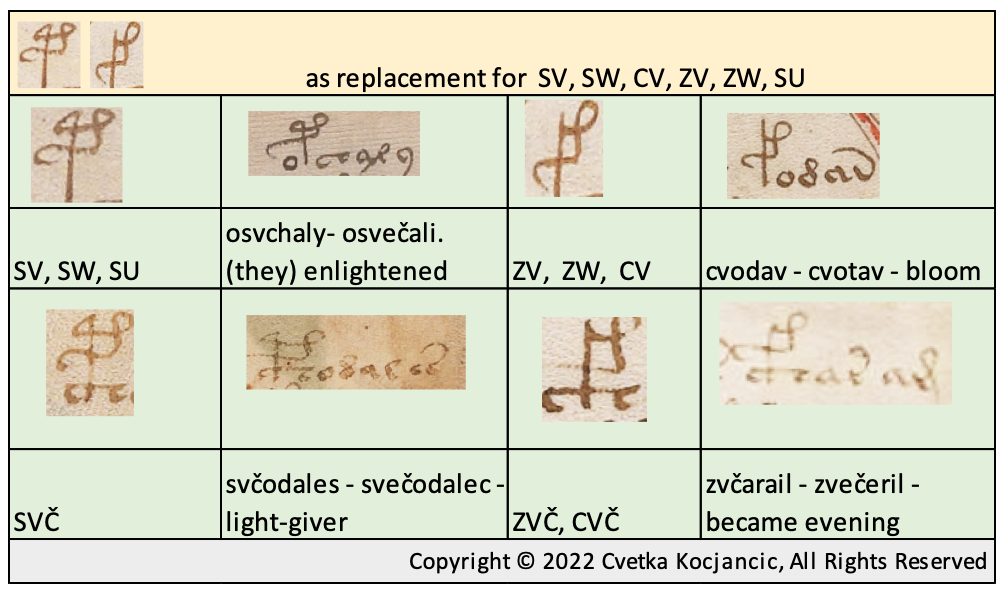
Letter F was very seldom used in Slovenian medieval writing. I noticed that in Swabian writing, like in other German, the V was often used for F. In Some Slovenian words and dialects, particularly Prekmurje dialect, V was often pronounced as F. This accounts for the missing F in my transliteration Voynich alphabet.
EVA-P needed to be replaced for Slovenian reading. Since there is no Q in Slovenian alphabet, and the P is one of the most frequent initial letters in Slovenian words, especially in the prefix PO, I use EVA-q for P, and EVA-p for the Slovenian sound SV.
I believe it was the author’s intention to differentiate the sounds SV and CV/ZV/ZW, but since they sound so similar, he had a lot of difficulty and used them most time interchangeably. The foreigners still have difficulty spelling Slovenian words containing CV as SV. My name CVETKA is most often being spelled as SUEDKA, but also as Quetka, Sueta, Svita etc. Even my own grandchildren cannot pronouce it properly.
Those sounds and letter combinations were also confusing to Slovenians.
It is not enough to determine which Latin letters and letter combinations were used for Slovenian language, because the priests from different linguistic background who first put Slovenian language in writing used their own writing conventions. This is how Slovenian language was written in three main writing conventions – German, Latin and Hungarian. This does not mean that one region used one writing convention, the other region the other, because the borders were often changing and so did the spelling influence.
In the comparative 15th century manuscripts I used for my analysis, various spellings for SW sound could be found.
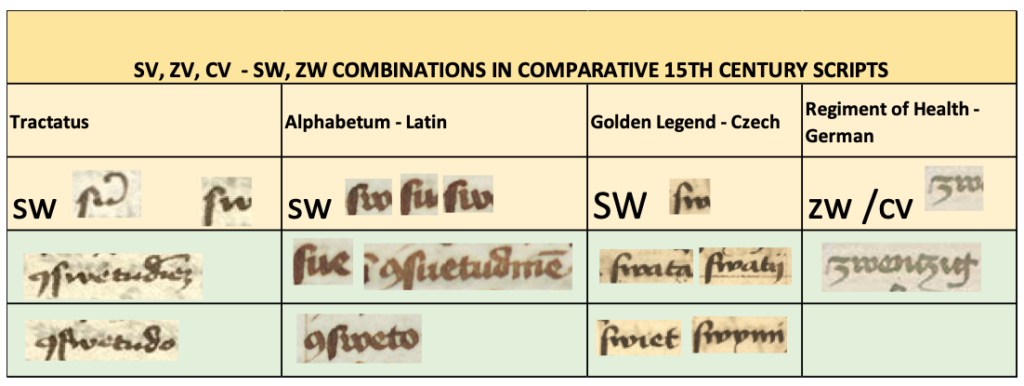
In all these combinations (sv, zv, cv, su, zu, zv, sw, zw, cv) u, v and w were used for the sound ‘u’, pronounced slightly different in different dialects.
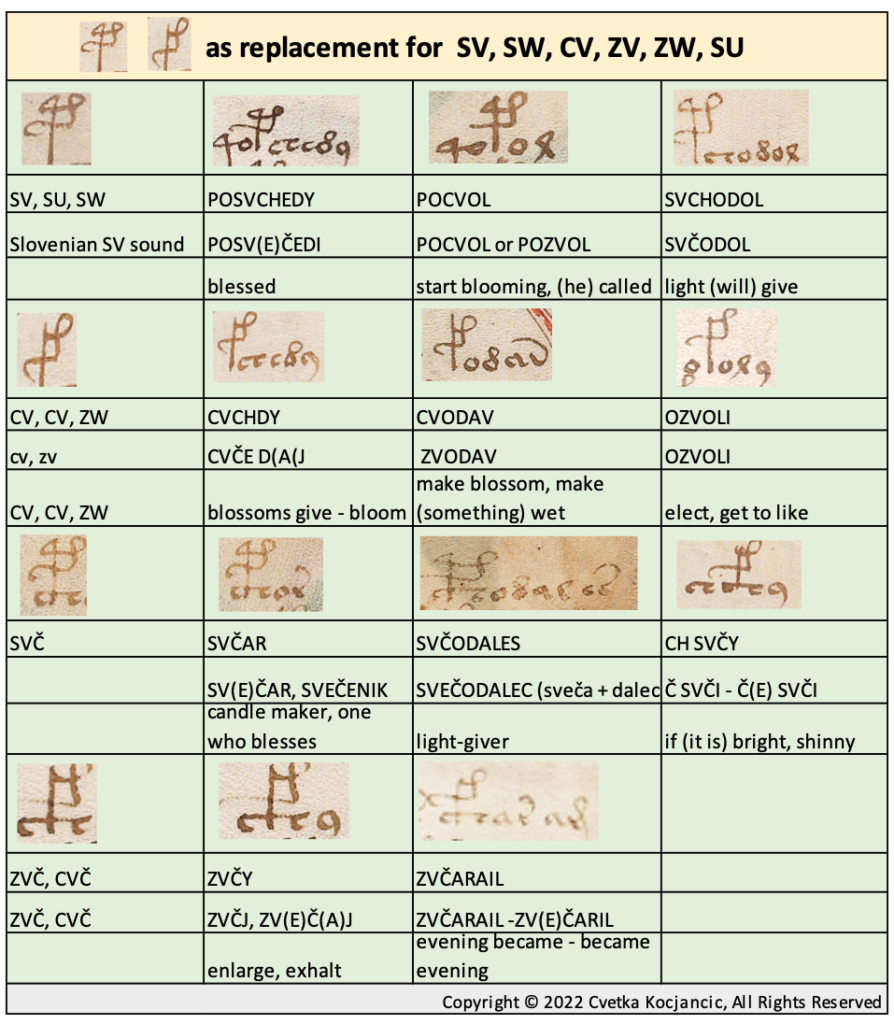
SV inserted into CH stands for Slovenian sound SVČ.
I had already proven that EVA-p does not stand for the letter or for the sound p, but rather for the sound ‘sv’ (Slovenian) or SU in Latin or SW in German. In Slovenian language, there are also ZV and CV sounds, which in Slovenian are distinct, like ZV in the word ZVON sounds different than ZW sounds in the German word ZWANZIG.
The spelling of the medieval Slavic prince SVATOPLUK is an example of various letter combinations being used for the Slavic sound SV: Svatopluk, Zuentepulc, Zuentibald, Sventopulch, Zvataplug, Svętopъłkъ, Świętopełk.
The table below offers some ideas how complicated Slovenian medieval language was.
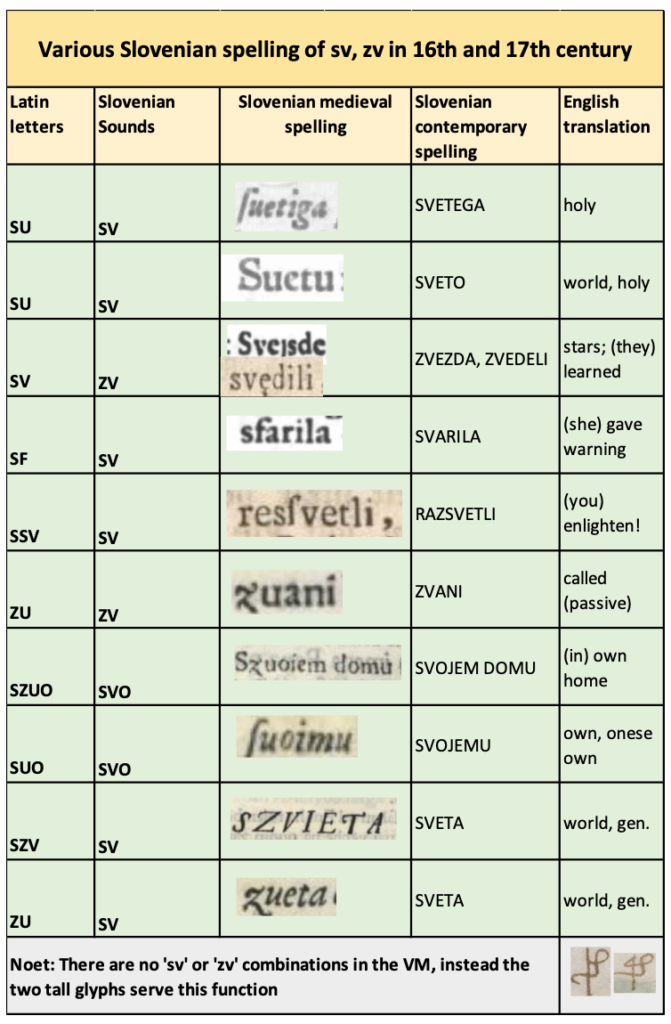
It is my belief that the two tall VM glyphs were intended to standardize the spelling of these unique Slovenian sounds across the entire Slovenian speaking territory.
Because the two gallows are used interchangeably, it is hard to get a distinct spelling. Also, there was some confussion about the sound of the letter ‘z’, which in Slovenian was used for c and for z (it also has similar shape in a cursive writing). In the VM, ‘z’ is frequently used in the word (r)oza (flower) and other words. The German cursive ‘z’ with a tail is not used in the VM.
From the Slovenian Etymology Dictionary, I have collected about 250 differently spelled words that start with SV, OSV, and POSV. Most of the variations are caused by different grammatical forms (which a foreigner might take for different words), however, for most of those words, there are about five different spelling variations of the root words. I would therefore not be surprised if the spelling in the VM is also somewhat different, however, from the context, the words could be better understood.
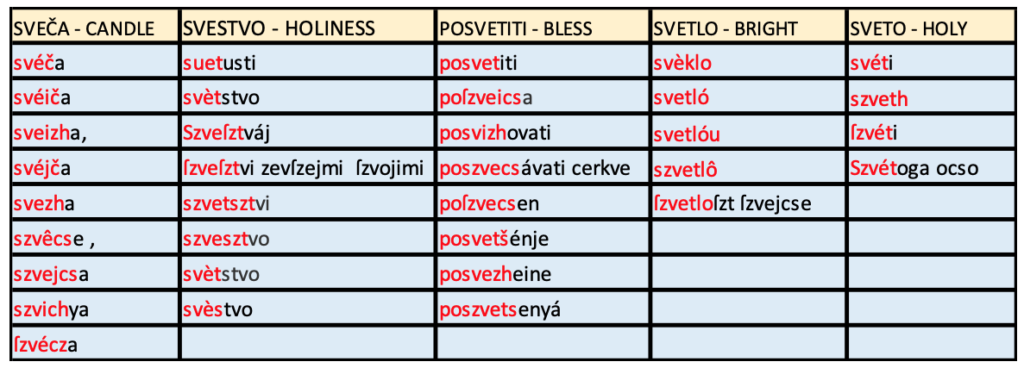
In the table above, I only focused on the root-word, the list of various grammatical endings would be too long. In the VM, there is approximatelly 1600 words that start with SV, SVČ, POSV, POSVČ, OSV, OSVČ (that also include CV and ZV words). This includes words in different grammatical forms, as well as multiple uses of the exactly the same words.
This might be hard to understand to those VM researchers who tend to think about medieval writing with a present grammatical mind-set.
This indicated that it is hardly possible that the words in the VM would be spelled exactly the same as in the Protestant writing 100 years later, when the writing was somewhat standardized in two writing conventions, German and Hungarian. The Hungarian spelling convention was used in Vramec’s Kronika, and German by almost all other 16th century writers.
What happened with the four unique VM glyps?
My identification of those four glyphs is based on the assumption that the Slovenian alphabet was created with great care by somebody who was well aquainted with Slovenian language, as well as with Latin and German. To my surprise, very few German or Latin words are used in the VM, except those who are shared and sound the same in Latin and Slovenian. To avoid foreign words, the author had to create many new Slovenian words, using the pattern he detected in the language. For example, there is a word SYAIIR in the first page, which I identified as a noun of the verb SYATI (to sow). The ending -ir indicates nouns of a male gender profession. I came from a peasant family and I never heard the Slovenian equivalent of SOWER, mainly because the Slovenian farmers did not use the noun, but only the verb. In literary Slovenian, the noun ‘sjajir’ changed to ‘sejalec’, so that the contemporary word is spelled as SEJALEC.
In a similar way, many SV- words had changed, like SVEČAR to SVEČENIK or to SVETNIK (a saint).
There is no written record that the four tall VM glyphs were actually used anywhere else, since there are no written documents in Slovenian, except for a few one- or two-page documents, containing Catholic prayer. I have identified them from the rest of the text, and because I could not find any other VM letters that could stand for the sounds K, T, SV, CV, ZV.
Slovenian was the first written Slavic language, and the Freising Manuscript is the first Slovenian (and Slavic) document written in Latin Letters. It was discovered in 1803 in Freising.
For all practical purposes, all Slovenian documents written in Latin letters were hidden in various monastery archives, or maybe in a copies that have not been preserved.
Primož Trubar is credited to write and publish first Slovenian book in 1550, that is, about hundred years after the VM was created.
Are there any clues that the Slovenian language existed in a written form hundred years earlier?
While the large part of Slovenia was under the Church authority of the Patriarchate of Aquileia, the use of glagolitza, known as Old Chruch Slavonic script, was used in liturgy. Glagolitza was also used by the Bogomils, a ‘heretical’ Slavic religious movement, which eventually gave raise to the Bosnian state religion, separated from Rome, until the mid-15th century.
The proof that the Glagolitza was also used by Slovenians are many inscriptions, including the one on the frescoe of Hrastovlje from the 1490, as well as the book by Georgius de Sclavonia, native of Brežice, while he was studying at the University of Vienna in 1400.
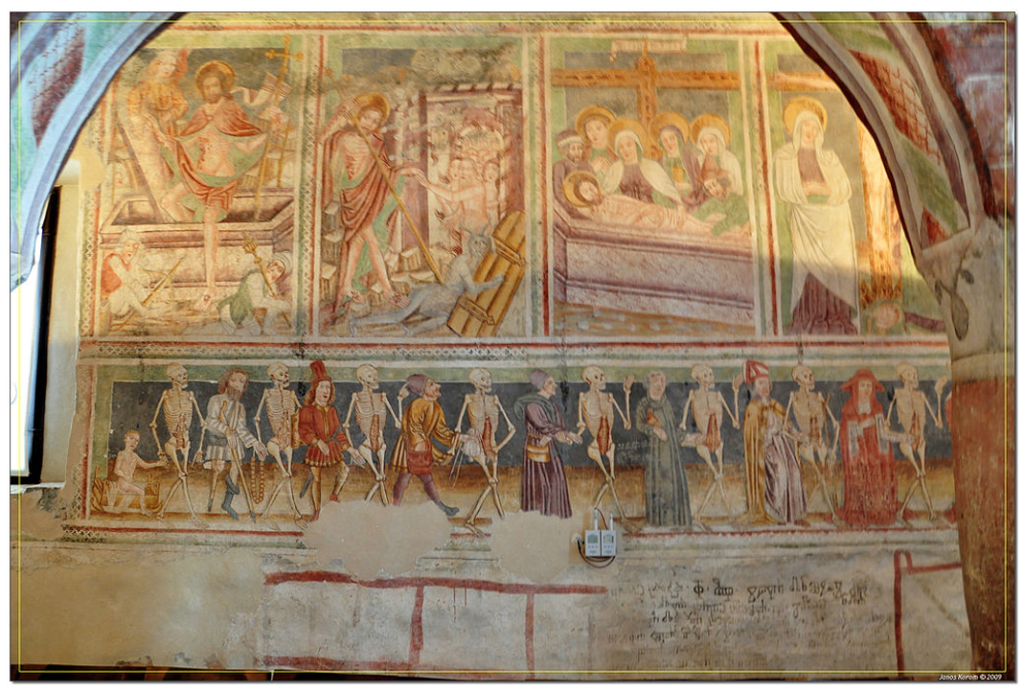
If the VM was the first longer Slovenian text in Latin letters, what was it used for? Assuming the author was Nicholas Kempf, he might have used it to practice writing in Slovenian, from the basic words needed for his religious work, in different Slovenian grammatical forms, to written spiritual notes and poetry. His humanistic, philosophical and political ideas are expressed mostly with illustration.
If the VM were the work of five authors, the monastic environment would be most likely place where such collaborative work could take place.
We can only imagine why the four tall VM glyphs did not make it into the Slovenian alphabet. While they were very practical for the cursive writing (requiring only one stroke), they were not practical for printing, because of their uniqueness. A German style of writing was adopted by the Slovenian writers of the 16th century.
The proof that the VM special letters went out of style is on the last page of the VM, believed to be added sometime later by a different scribe. This is suggestive that for a certain period, the VM glyphs were used, becaise the word OROR is written exactly the way as in the VM, while other letters are typical of Tyrolian/Slovenian use of Latin letters. Even if the text on the last page were to be written by the same author, he would have switched to the common letters in use, or he would have reverted to the writing he first learned, remembering only the way he used to spel the word OROR (prayer).
If there was more documents written in Slovenian, they would have been destroyed by the Counter-Reformation, if not by Turkish invasions.
Some Examples of the SV/CV in VM words
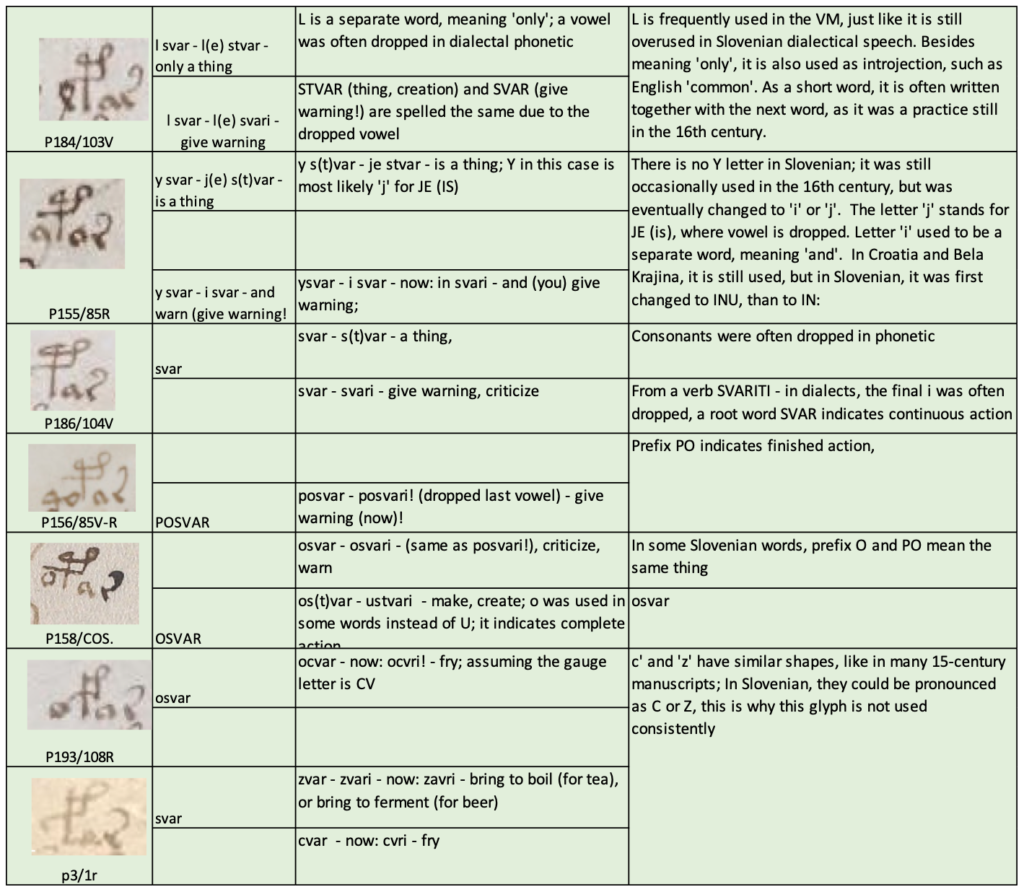
The above table is showing various prefixes (and what looks like a prefixes) of the VM root word SV/ZV.
The grammatical endings are more versitile, because the Slovenian language is highly inflective. Due to the dropped vowels, the length of the vowels, and accent, the spelling of different words often overlaps, which accounts for a different translation of seemingly the same words. (They differ in pronunciation, if not in spelling.)
I believe the author’s intention was to distinguish the similar sounding words with a strike-through marking, or with EVA ch/sh differentiation, which is even for the Slovenian speaker very difficult to distinguish, mainly because of the sound-changes over time, and palatization.
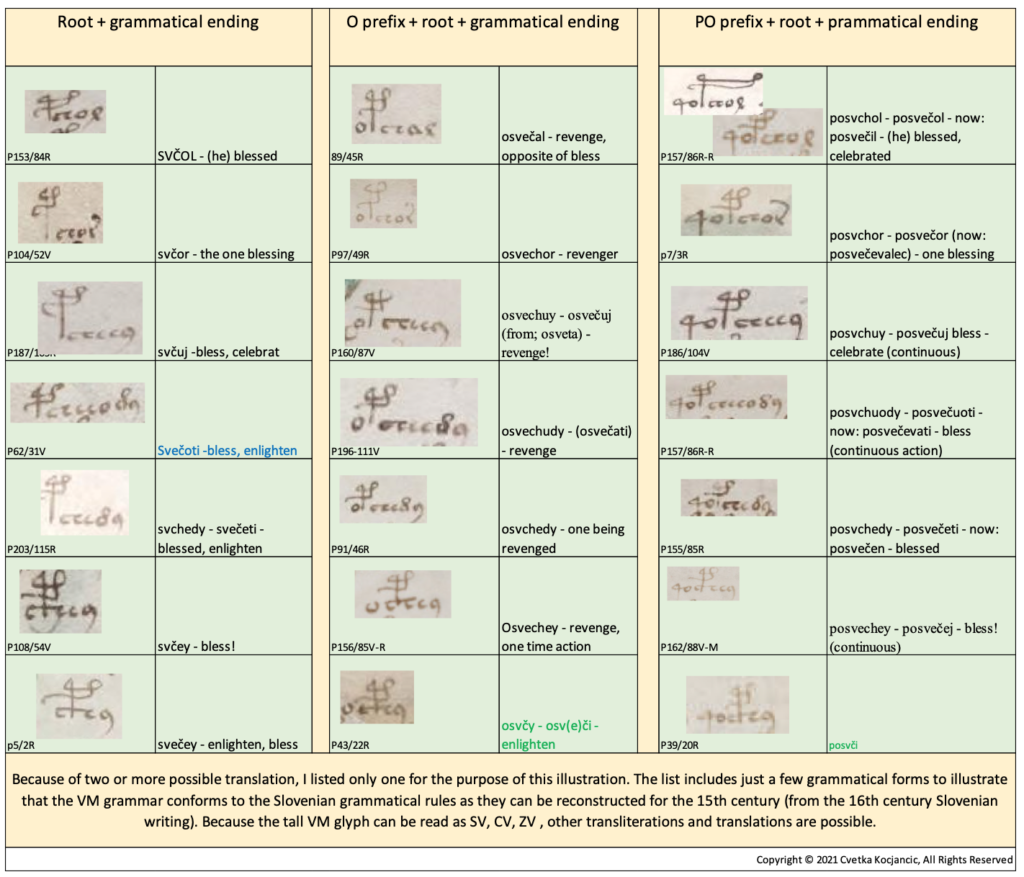
The table above illustrates the use of prefixes O and PO. The prefix O is usually used to make the oppposite – such as SVEČAL – OSVEČAL (from the nous: OSVETA – blessing – revenge), or DATI – ODATI (give – give away). This is one Slovenian word that retained a double D, but in the VM it is spelled with only one D. It can also be used for a finished activity, such as SVETITI – OSVETITI (shine – make (something) shinny and visible), or the word pair DATI – O(B)DATI (give – give (put) around).
Because of the variety of Slovenian grammatical ending, a word can be a verb in one case (SVEČO- I was blessing), or noun in other (SVEČO – candle, accus. case).
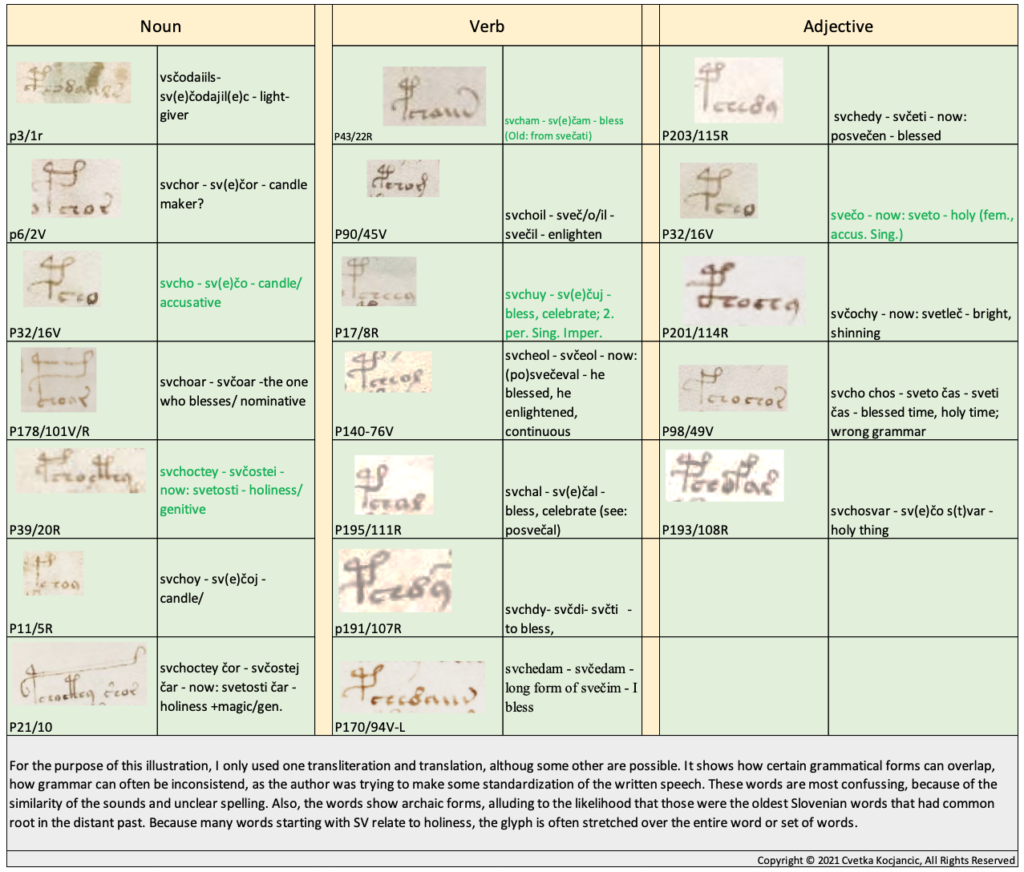
The table above shows some examples of the SV-words. Because some sounds have morphed over time, it requires a lot of effort to get a proper meaning, like SVEČOST (in VM) evolved into SVETOST (holiness). Often, the SV words related to holiness are marked with embelished initial SV.
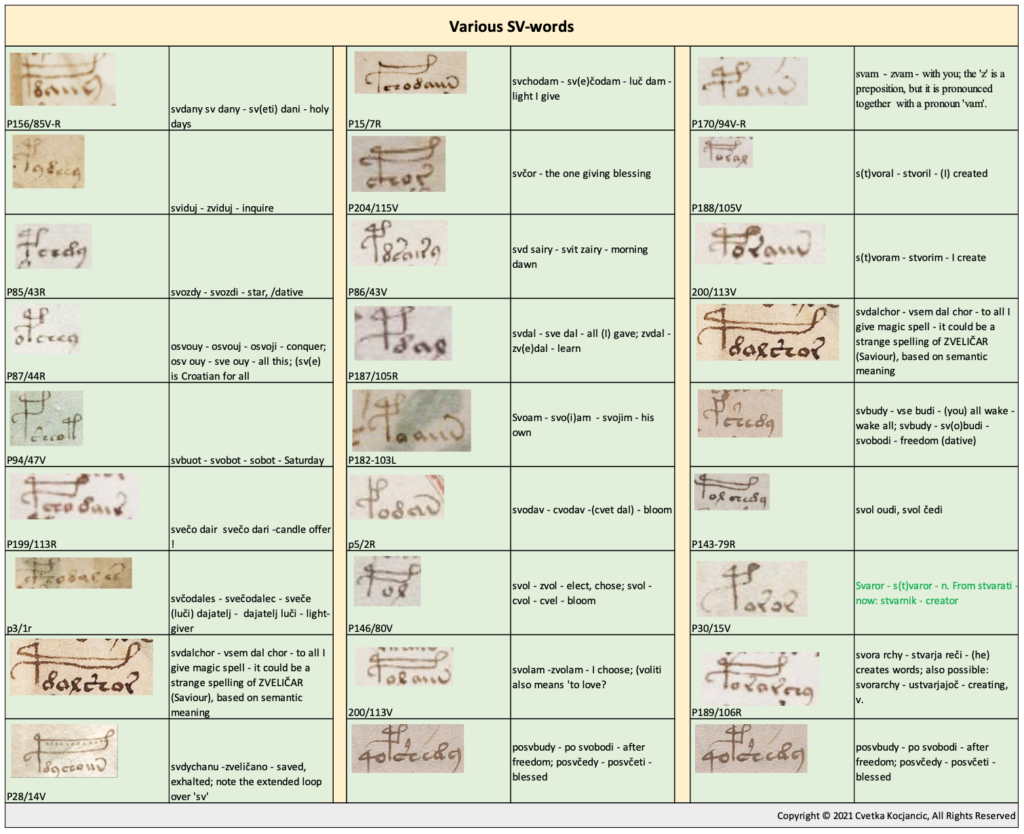
The words containing VM glyph would require further study and reading in the context, separating different sounds, such as SV, CV, ZV, and different spelling (ch, sh, strike-through). The intention of this article was to show that the two unique VM glyphs are used throughout the for either one of the three sounds, most of the time interchangeably (due to the similarity of the sounds), and that they conform to similar grammatical rules as the other tall glyphs – K, T. The other two tall glyphs are related to the words holy, world, light, blosson, star, bell, chosen, advice, criticism, warning etc., which accounts for their equal distribution throughout the manuscript. Some of the glyphs related to ‘holy’, are embellished by the loop being stretched over the entire word, or a string of words.
If the handwriting was more clear, it would be easier to transcribe properly, particularly ‘oz’ and ‘ch’. Because of the similarity of the sounds, it is also very hard to properly translate into Slovenian, even for a Slovenian speaking person, because the author used the words in different grammatical forms that have never been used before and was confronted by another problem, namely the way the sound often change with the grammatical form. For example: He used POSVEČI, but the ‘č’ eventually changed to T (posveti).